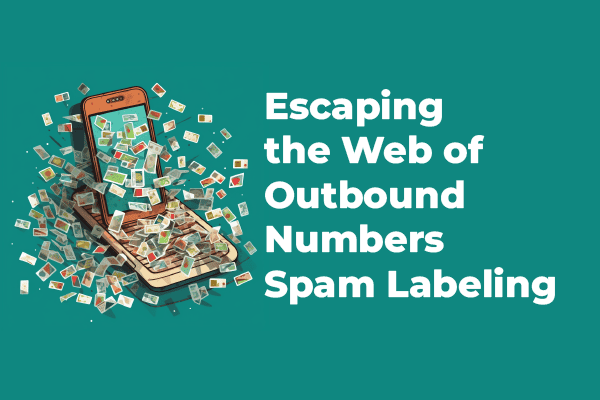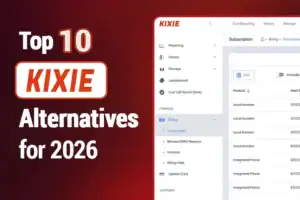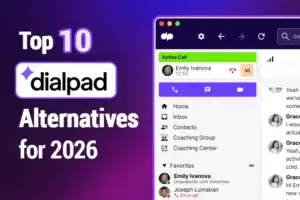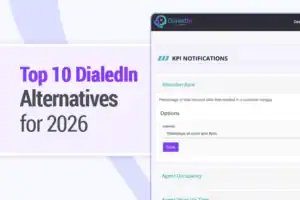When it comes to business communication, one common issue you might face is having your numbers labeled as spam. Legitimate businesses find themselves grappling with the consequences of having their calls inaccurately classified as scams or spam. The intricate mechanisms behind call labeling and the factors influencing the classification of calls have become a focal point for contact centers striving to maintain effective communication with their clients.
In this article, we delve into the world of call labeling, dissecting the nuances and shedding light on the factors that contribute to this complex issue. By understanding the processes and systems at play, businesses can navigate the intricate landscape of call labeling and develop strategies to mitigate its negative impacts on their operations and public image.
Have you ever wondered what it means when your number is marked as spam? This labeling typically occurs when recipients report your calls as unwanted or intrusive.
When numbers are marked as spam, it can have detrimental effects on a company’s outbound campaigns and customer engagement. Legitimate business calls that are labeled as spam face the risk of being disregarded or ignored, resulting in a hindered ability to connect with clients and convey important information. The consequences of this labeling extend beyond missed opportunities, as they can negatively impact a brand’s reputation and erode customer trust.
However, the threat of ill-intent calls is real. According to DataPort, in 2020, Americans received an estimated 46 billion robocalls or spam calls. And to add salt to the injury, scam calls make up most of the robocall deluge, accounting for 25.9 billion or 44% of all robocalls, according to USAToday.
To effectively tackle this issue, it is crucial to understand the reasons behind customers perceiving these calls as unwanted or intrusive. This requires a thorough analysis of the content, frequency, and timing of the calls, ensuring that they align with customers’ expectations and preferences. Implementing transparent communication practices, seeking consent, and providing opt-out options can significantly help in reducing the likelihood of being labeled as spam. Let’s take a closer look.
Reasons behind Spam Marking
There are numerous factors contributing to your number getting flagged. These include too many calls in a short span of time, unsolicited calls, irrelevant content, and the recipient not recognizing the calling number.
Robocalls are one of the main culprits in this scenario. An increasing number of businesses are using automated calls for telemarketing, customer support, and other communication purposes. However, this has also led to a rise in unsolicited robocalls, leading authorities, and service providers to flag suspicious numbers to protect consumers.
The frequency of calls is another factor that can lead to your number being flagged. If your business is making numerous calls to the same number or a large number of calls in general, it could raise suspicions and result in your number being marked as spam.
We generally like to group the reasons in two categories:
Illegal Activities
Maybe the primary reason for calls being labeled as spam (or even blocked) relates to the possibility of engaging in illegal activities, whether knowingly or unknowingly. It is important to understand that numerous regulations, spanning state, federal, and industry-specific realms, can have adverse and hard-to-identify effects on your numbers due to their overlapping nature.
High Level of Nuisance
Another significant factor leading to the labeling (and possibly blocking) of numbers is when a company engages in legal call behavior that its subscriber base finds displeasing.
There are several reasons why people may develop a dislike for your calls: besides the high call frequency, the purpose of your call may be perceived negatively by the client. In essence, if your (legitimate) calls evoke any form of dissatisfaction among your client base, there is a risk of being labeled or blocked.
The process is straightforward: when a sufficient number of individuals register complaints about your calling behavior, it inevitably results in one or more numbers being labeled and eventually blocked.
<INSERT EBOOK IMG>
You can learn more about what can negatively impact your numbers and how to avoid them by downloading our free on-demand eBook (Call Labeling and Blocking for Contact Centers).
Get your free, on-demand copy here.
Recognizing the “Phone Number Marked as Spam” Warning Signs
Staying proactive can help prevent your number from being marked as spam. There are several early warning signs that you should watch out for. If you notice any of these, it’s a signal to reassess your communication strategy and ensure compliance with regulatory guidelines.
Decreased engagement
If your call answer rates are significantly dropping, it could mean that your calls are being flagged and your customers are being alerted before they pick up.
Customer complaints
If customers start complaining about spam alerts when they receive your calls, it’s an indication that your number has been flagged. It’s essential to address these issues promptly to prevent further damage to your business reputation.
In the realm of outbound calls, perception is everything. To recognize if your calls are being labeled as spam, pay close attention to the response rate and customer feedback. If you notice a sudden decline in engagement or an influx of complaints, it’s a strong indicator that your calls might be perceived as spam. – Christian Montes, Executive Vice President Client Operations @ NobelBiz
Impact on Your Contact Rates
When your number is labeled as spam, your communication effectiveness decreases dramatically. Your calls may not even reach your intended recipients as they’re automatically filtered out or blocked by the network or device settings.
Proactive steps to prevent the spam label
By preventing calls from being marked as spam, companies can protect their brand image, build and maintain customer trust, seize opportunities for meaningful communication, and ensure compliance with applicable regulations.
This is why the rest of the article focuses on some of the most important steps companies can take to prevent their calls from being labeled as spam.
Of course, these are preemptive measures. If you suspect your calls are already labeled, we suggest getting in touch with one of our experts here.
Preventing the Negative Impact of High Call Volume
The frequency of calls from a specific number plays a significant role in determining labels. A high volume of calls within a short period may indicate illegal use of robocalls. While there may be legitimate reasons for making numerous outbound calls, without proper number management and dialing strategies, this behavior often leads to labels or blocks. Carriers have the ability to identify spam calls and assist in prosecuting offenders by monitoring their contact frequency with specific numbers.
Embracing Ethical Telemarketing Practices
Ethical telemarketing practices include respecting the National Do Not Call Registry, providing accurate caller ID information, and refraining from deceptive sales tactics. Upholding these practices not only preserves your reputation but also decreases the likelihood of your phone number being marked as spam.
Optimal Use of Dialing Software
While dialing software can amplify your outreach capabilities, it’s essential to use it within ethical boundaries. For instance, avoid dialing patterns that are characteristic of spam calls, such as excessive redialing.
Pro tip: ensure that the software correctly displays your caller ID and doesn’t spoof numbers.
If you’re looking for a dialing powerhouse, look no further than NobelBiz OMNI+, our complete cloud-based contact center solution with advanced dialing modes and out-of-the-box outbound filters to keep your numbers safe from labeling and litigation.
The Value of Compliance with Regulations
Compliance with federal and state telemarketing regulations is not only a legal requirement, but it can also help maintain your phone number’s reputation and prevent it from being marked as spam.
Strict adherence to telemarketing regulations is crucial for both legal compliance and maintaining a positive phone number reputation. Familiarize yourself with laws such as the Telephone Consumer Protection Act (TCPA) and the Telemarketing Sales Rule (TSR) to avoid penalties and maintain good standing.
Compliance isn’t just a legal obligation; it’s a strategic imperative for businesses looking to prevent their numbers from being labeled. By adhering to regulatory requirements, companies can safeguard their reputation, build trust with customers, and avoid the detrimental consequences of being flagged as spam. – Brad Butler, Contact Center Software Consultant @ NobelBiz
<insert Safe Select IMG>
If you are looking for a comprehensive, cost-effective, and future-proof compliance suite for your outbound business or department, you might want to look into Omni+ powered by Safe Select, one of the most convenient and easy-to-use CCaaS solutions that can remain compliant with the federal TCPA and individual state laws.
Regular Monitoring of Phone Number Reputation
Monitoring your phone number’s reputation is as crucial as maintaining a good credit score. Many online platforms provide reputation scores for phone numbers based on user feedback and spam alert systems. Regularly checking these platforms allows you to gauge your standing and adjust your communication strategies accordingly.
A robust number management strategy is the compass that guides businesses through the labyrinth of call labeling. It empowers companies to proactively monitor and optimize their calling practices, ensuring accurate identification, effective engagement, and a minimized risk of being labeled as spam. – Christian Montes, Executive Vice President Client Operations @ NobelBiz
Building Strong Carrier Relationships
Establishing strong relationships with carriers opens up opportunities for collaboration and assistance. These relationships can help you proactively address potential spam flags on your phone number and provide insights to help you improve your reputation.
The NobelBiz Voice Carrier Network: a carrier you can rely on
The NobelBiz Voice Carrier Network stands tall as the unrivaled choice among VoIP Interconnected Providers. With robust global redundancies ensuring uninterrupted uptime, we guarantee impeccable voice quality at a competitive price.
The NobelBiz Voice Carrier Network is built from the ground up with the sole purpose of serving the contact center industry, having no rivals in terms of services, coverage, and pricing. NobelBiz offers one of the most versatile selections of built-in smart tools designed to:
- Increase contact rates and productivity
- Help mitigate the impacts of call labeling and blocking
- Provide all-around compliance etc.
Our finely tuned features and support processes maximize efficiency and quality and cater to the dynamic demands of both inbound and outbound voice traffic.
Ask for a cost-per-minute quote here.
Proactively Addressing Customer Feedback
Embrace transparency and attentiveness to address customer feedback. If a customer reports that your call was flagged as spam, investigate promptly and take the necessary corrective action.
Maintaining Updated Call Lists
Regularly update your call lists to ensure they don’t contain numbers listed on the National Do Not Call Registry. Non-compliance can lead to spam flags and damage your reputation.
Strategies to Avoid Labels and Increase Contact Rates
The preemptive methods we’ve just outlined will help you keep your numbers relatively safe. But what if spam labels already plague your outbound campaigns? The good news is there are immediate steps you can take to avoid the spam label and boost your contact rates. Let’s dive into the six strategies.
- Dial Smarter, Not Harder
“Dial smarter, not harder” implies being strategic about your calling practices. It’s about quality over quantity, ensuring your calls are targeted and meaningful rather than sending mass, unsolicited calls.
Tips to Achieve This
Create a calling schedule based on the most likely times your recipients would be available to answer. Segment your contacts based on their preferences and engagement level, and personalize your messages for a more effective outreach.
- Adapt to STIR/SHAKEN Standards
STIR/SHAKEN is a set of technical standards developed to combat caller ID spoofing. Adhering to these standards ensures your calls are authenticated and verified, increasing the chances of them being received.
How to Apply These Standards
You can implement these standards by working with a telecommunications provider that supports STIR/SHAKEN. They will authenticate your calls, verifying your identity to the receiving party’s network.
Check out our free, on-demand webinar on Call Labeling and Blocking in the Age of STIR/SHAKEN
- Utilize the Right Number of DIDs
DID stands for Direct Inward Dialing. These are virtual numbers that allow you to route calls to your existing telephone lines.
Identifying the Right Number of DIDs
The right number of DIDs varies based on your business size and call volume. Having too few may lead to call congestion, while too many could be seen as suspicious. Work with your provider to find the ideal number for your needs.
- Use Omnichannel Outreach
Importance of Omnichannel Outreach
Omnichannel outreach involves reaching out to your audience through various channels – not just phone calls. This could include email, text messages, social media, and more.
Steps to Implement It
Identify the platforms your audience uses most, and tailor your outreach strategies to suit these channels. Remember to keep your messaging consistent across all platforms for a seamless customer experience.
Learn more about the NobelBiz complete omnichannel solution here.
- Increase Speed to Lead
Speed to Lead refers to how quickly you respond to new leads. The faster you reach out, the higher your chances of converting that lead into a customer.
Ways to Enhance It
Automation tools can help you respond swiftly to new leads. Additionally, training your team to follow up on leads promptly and effectively can significantly improve your Speed to Lead.
- Adhere to TCPA and State/Local Guidelines
TCPA, or Telephone Consumer Protection Act, is a U.S. regulation that protects consumers from unsolicited calls and messages. Adherence to this act is crucial to avoid legal complications.
Importance of Adherence to Guidelines
Complying with TCPA and local guidelines not only keeps you on the right side of the law, but also builds trust with your contacts. It shows respect for their rights and preferences, enhancing your business reputation.
Conclusion: Persistence is Key
In the world of business communications, vigilance, and proactive measures are vital to prevent your phone number from being flagged as spam. Implementing the strategies discussed, such as adopting STIR/SHAKEN standards, monitoring phone number reputation, using dialing software appropriately, maintaining carrier relationships, complying with regulations, addressing customer feedback, and updating call lists, you can ensure the integrity of your phone number and keep your communication channels open and efficient.
If you need help, or assistance or you just want to ask a simple question about the spam labels or call blocking, don’t hesitate to give us a call at 760.405.0105 or just leave us a message here.

Michael McGuire is a contact center industry expert with almost two decades of experience in the space. His experience includes roles as Director of Contact Center Digital Transformation at NobelBiz, and as Director of Operations at FLS Connect, managing multiple call centers. As President of Anomaly Squared and Targeted Metrics, Michael successfully transitioned companies into remote operations and significantly boosted revenues. With a strong background in customer service, leadership, strategic planning, and operations management, Michael excels in driving growth and innovation in the call center space.
Mike is also a proud Board Member for R.E.A.C.H Trade Group, promoting consumer protection and satisfaction and Co-host of the Off Skripted Podcast – a show about Life, Call Centers and everything in between.






